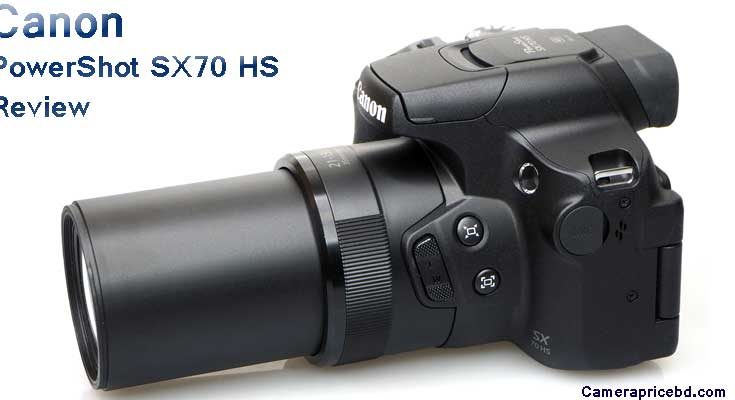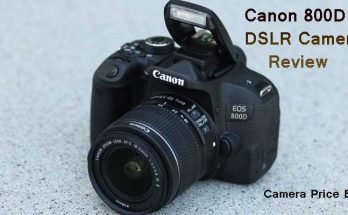Canon PowerShot SX70 HS Review With a 1/2.3-inch sensor at its heart, just so much ought normal of the Canon PowerShot SX70 HS’s picture quality. So, satisfying outcomes at mid-range focal lengths, together with an exquisite electronic viewfinder, effective image stabilization, good autofocus performance, and speedy operation make it a pleasure to shoot with.

Canon PowerShot SX70 HS in women’s Hand
Canon PowerShot SX70 HS Full Review 2019
Traditional smaller cameras may have to a great extent dropped out of style yet their superzoom connects cousins keep on being a practical option in contrast to DSLR and mirrorless frameworks. A huge piece of this, obviously, is down to the extent of their optics, yet the latest models have undeniably something other than humongous zoom reaches to lure sharp picture takers.
Group’s most recent Canon PowerShot SX70 HS is one such model. While the primary draw of its 65x optical long range focal point is (to some degree curiously) unaltered from the model it refreshes, it’s outfitted with a great cluster of extra innovation, from crude catch, 10fps burst shooting, and remote network through to 4K UHD video.
While generally little and lightweight, the camera’s profound grasp enables you to get a decent hold, and it’s pleasant to find that it doesn’t turn out to be too front-overwhelming when the focal point is completely broadened. Assemble quality could be better, however, and there’s no climate fixing.
The camera’s autofocus system works in great time and shot-to-shot occasions are generally excellent, notwithstanding when catching crude documents, in spite of the fact that a quick memory card exhorted. With the natural EOS-style menu framework you have awesome command over your catches as well, in spite of the fact that it’s impractical to apply various Styles (shading settings) to pictures when shooting crude documents, and post-catch crude preparing is likewise tragically not given.
For a camera with such a little sensing element, the PowerShot SX70 HS is capable of terribly pleasing output. Exposures are largely fine, although the limited dynamic range does mean that highlight details can blow in high-contrast scenes, so using the Auto Lighting Optimizer is a good idea.
There’s good detail in images in the middle part of the focal range, while the image stabilization system does well to keep captures at the telephoto extreme relatively sharp, although wide-angle results and anything captured indoors at moderate ISO settings and above are noticeably worse.
In good light, videos captured at the maximum 4K UHD resolution hold up well, and there’s a decent amount of control offered over recording – even a mic port – although it would be nice to have a built-in ND filter to help better control exposure.
While there square measure higher superzoom choices at this worth purpose – the Panasonic Lumix FZ1000 being the foremost obvious example – the PowerShot SX70 HS brings along an honest deal of management and a colossal zoom within a compact package. Stronger wide-angle results and better results at higher ISO settings would make it a more consistent performer, but if you’re a Canon fan and imagine you’ll be regularly shooting in the mid-telephoto vary, the PowerShot SX70 HS may simply be the solution.
Who’s it for and should I buy it?

Canon PowerShot SX70 HS Body
As a do-it-all camera, the PowerShot SX70 HS seems to possess a lot of to suggest it, whereas its terms rival those of most entry-level interchangeable lens systems. Canon’s marketing for the camera makes its target audience clear: this is a model aimed at those who want the control of a DSLR and a massive zoom lens at their disposal in one convenient package.
Canon PowerShot SX70 HS Price
- Current price: £519/ $549 / AU$749.95 / AED 2,499 / BDT: 42,000 Taka.
Also Check: Canon PowerShot SX70 HS Digital Camera Price & Specifications in Bangladesh
Positive Points
- Great zoom range with 21mm (equiv.) start
- Lovely handling
- Effective image stabilization
- Decent 4K video results
- Lightweight body
- Competent AF system
Negative Points
- No Touchscreen
- Build quality feels cheap
- Wideangle performance isn’t great
- Lack of slow-motion video options
- Styles not possible in raw
- No USB charging
Tiny but packed with features
- Raw shooting, including new CR3 mode
- ISO 100-3200
- 4K UHD video at 30/25p

ilhouette of girl in the sunset captured by PowerShot SX70 HS
The PowerShot SX70 HS is constructed around a lens comparable to 21-1365mm in 35mm terms, with a most aperture of f/3.4-6.5. No change from its PowerShot SX60 HS predecessor then, although the presence of the latest DIGIC 8 engine means that the camera’s image stabilization system can provide up to five stops of correction among other things.
Also new is the sensor, a 20.3MP back-illuminated device, up from the previous camera’s 16.1MP alternative. While the scope of the lens means that it measures just 1/2.3-inch in size, the fact that its sensitivity range only stretches between 100-3200 may disappoint some. Still, with a more effective stabilization system than before, perhaps you won’t need to reach the higher settings as frequently.
The camera captures both raw files and JPEG images, with the former now storable in Canon’s CR3 Raw format. This was introduced in the EOS M50 back in February, and its main advantage over its CR2 predecessor is that it can store smaller raw files captured at full resolution but in a smaller size.
Videos, meanwhile are recorded at up to 4K UHD resolutions, with 30p and 25p option offered here, but no 24p option. You can record at up to 60p when shooting in Full HD, which may bother some expecting the customary slow-motion output options such as 100/120p shooting. For creative users, however, the camera somewhat redeems itself with a time-lapse option that outputs results in 4K.
Working on the contrast-detect AF principle and with simply 9 points that inherit play in its default car setting, the autofocusing system is somewhat underwhelming on paper, although you can move one purpose around the screen to a lot of precise purposes if you would like to. Furthermore, you can focus 0cm away from the subject for macro work, while manual focus with the assistance of focus peaking is also on hand. Those shooting action can capture bursts of ranges at a rate of 10fps, although this drops to 5.7fps with continuous focus.
Wi-Fi is joined by Bluetooth, and between these, the camera is able to send images wirelessly and be controlled remotely from an iOS or Android device. There’s no GPS system as such, although it is possible to embed GPS data into images when using the Canon Camera Connect app.
Battery life ranges from 255 shots per charge when using the LCD through to 325 when relying on the rear display, although the Eco mode boosts this to around 405 frames. A slot around the base accepts SD, SDHC, and SDXC cards too, with support for UHS-I cards designed to the Class 3 standard.
Lightweight Body with Great Handling
- Deep grip makes handling very comfortable
- LCD screen can be physically adjusted
- Power control slightly awkward to access

Dad and son jumping into the ocean captured by PowerShot SX70 HS
As is now standard practice for such cameras, the PowerShot SX70 HS combines an electronic viewfinder with an articulating LCD screen. The EVF has a respectable 2.36-million dot resolution – a healthy boost over the 922k-dot LCD panel inside the SX60 HS – and so it makes perfect sense that in good light it performs to a great standard. Details are very good, as is contrast, and colors appear to be nice and accurate. It also benefits from an eye sensor to its side, which means you don’t have to worry about manually switching the feed between the LCD and EVF.
When you consider the watery, noisy viewfinders with occasional color casts that you tend to find on such models, you appreciate just how well this one performs. That said, as soon as light levels start to dip, the slight muddiness of details makes it more difficult to see whether the focus is precise, so you do place a little faith in the camera to get things right here.
The 3-inch LCD has 922k dots and can be twisted to face the front. It’s not a touchscreen, however, which may irk those used to jabbing their smartphones and tablets, but it also performs to a standard befitting such a model, with easy movement and its thick profile letting you get a good grip on it. You also get a slightly cut-down version of the EOS interface in both the LCD and EVF and this includes a customizable My Menu tab, which will no doubt please existing Canon users already accustomed to this UI.
While the PowerShot SX70 HS isn’t a large camera, the depth of the grip and space on the rear for the thumb makes it a perfectly comfortable camera to hold. Handling is further helped by a mode dial that stands proud from the top plate and a shutter-release button with clear feedback between its various positions when pressed. The top plate also hides a built-in flash with a reasonable selection of control through the menu, although Canon chose to drop the hot shoe from the design of the PowerShot SX60 HS here, which suggests that external units cannot be mounted.
The top plate is also home to the power and Wi-Fi buttons. It’s a shame these aren’t placed the other way around from each other as the more frequently used power control is harder to reach with the forefinger. The zoom control on the camera’s lens barrel also seems a little too high for comfort, although if you have large hands you might not mind this too much. You can also zoom with the collar around the shutter-release button, so you may end up not using this secondary control at all.
Image quality
- Effective image stabilisation system
- Capable of pleasing 4K video quality
- Lacklustre wide-angle performance

close up of water drops captured by PowerShot SX70 HS
Cameras designed as an alternative to DSLRs and mirrorless cameras can often underwhelm when they’re compared with the standard of entry-level interchangeable-lens models, but the PowerShot SX70 HS does well to break this convention. At least in terms of operation, it’s far more pleasing to use than expected.
On top of the great handling, a lot of this is down to the camera’s autofocus system, which generally brings subjects to focus speedily. In good light it manages to do this wherever you are in the focal range, although this does dip in sub-optimum light and when shooting lower-contrast subjects, which is admittedly fairly standard on such cameras.
Shot-to-shot times are also very good, even when shooting raw files, which is particular useful at the telephoto end when you might want to capture a few frames to compensate for less-than-steady framing. The image stabilisation system does a very good job to keep the feed as stable as possible, however, and it’s usually possible to get precise composition with just a handful of frames, particularly when you provide extra stability with your face as it’s pressed up to the viewfinder.
If you want to vary the colour output you can call upon a selection of Styles such as Vivid and Neutral, although the PowerShot SX70 HS follows previous Canon models in disabling this option when capturing raw frames (or simultaneous raw and JPEG frames). This is slightly annoying, particularly if you’re used to adjusting these on a more advanced Canon camera.
On the default Auto setting, however, colors manage to have a nice punch to them while still being true to life. Exposures are generally fine too, with just minor overexposure when faced with scenes containing fewer brighter details.

Kids sitting on paddle board captured by PowerShot SX70 HS
The camera typically outputs the kind of results we should expect from a 1/2.3-inch sensor – that is to say fine when sticking to the lowest sensitivities in good light and slightly struggling elsewhere. Particularly at middle-range focal lengths, images show very good detail, and even at the telephoto end there’s just a touch of noise reduction and softness marring an otherwise very acceptable performance.
Results at the wide end of the lens, however, are noticeably weaker, particularly as you move away from the base ISO 100 setting, with a coarse texture and general loss of detail, so if you imagine you’ll be relying on this end with any frequency you may want to look elsewhere.
Optical aberrations square measure usually well controlled, with curvilinear distortion not being an issue at either end of the lens and vignetting only really visible in the types of scenes most troubled by it. Chromatic aberration is handled well too, though purple fringing is usually visible in areas of high distinction.
Videos captured in the maximum 4K UHD resolution are perfectly pleasing when you’re shooting in good light, particularly when you consider what other cameras with such a sensor deem to be acceptable here, although the lack of a built-in ND filter (which, admittedly, we wouldn’t expect in such a model anyway) may make capturing footage outdoors a struggle.




